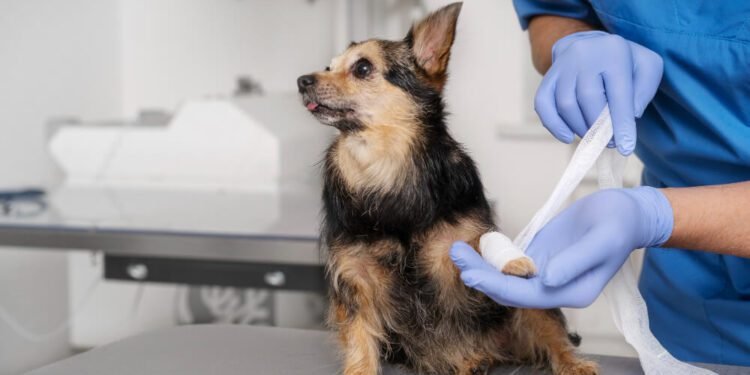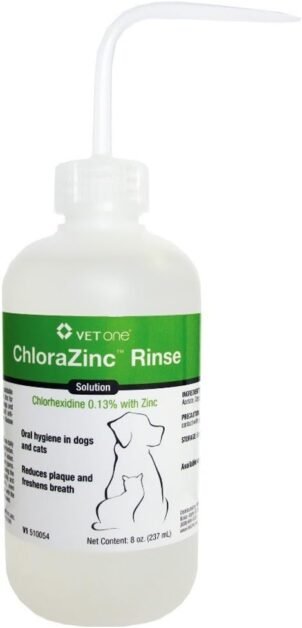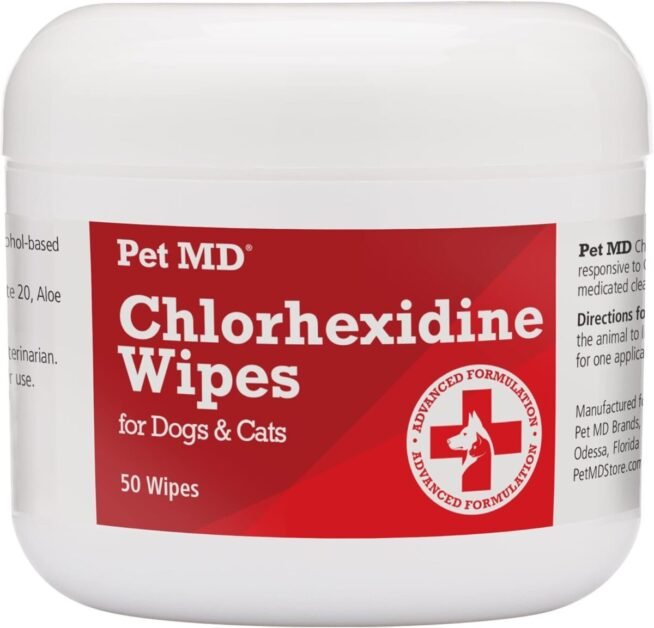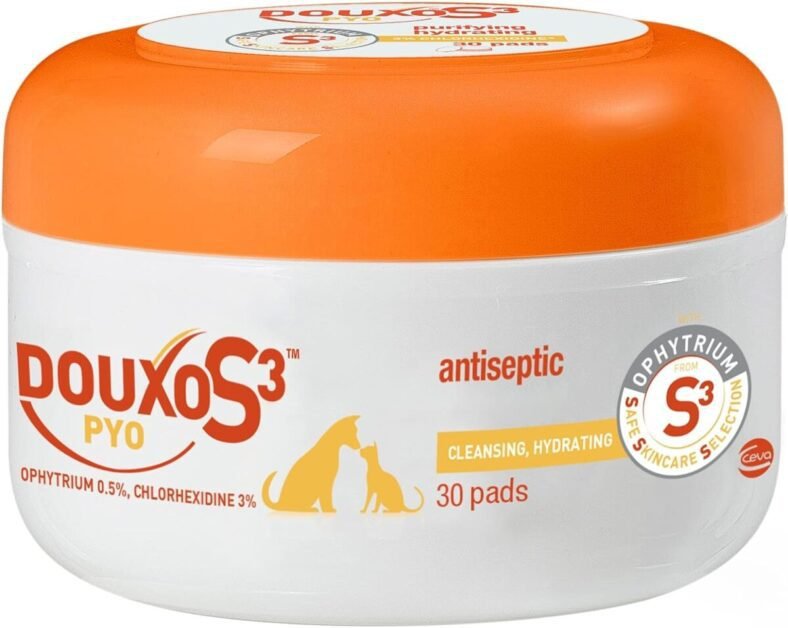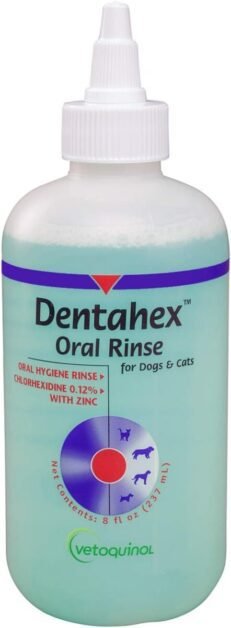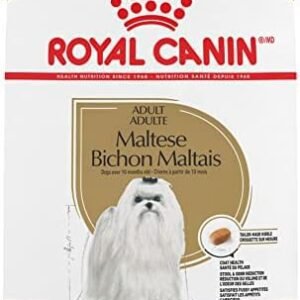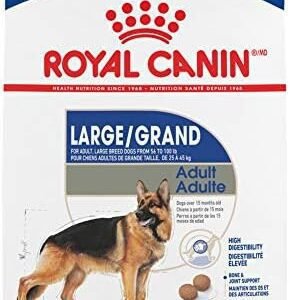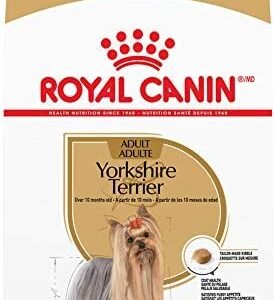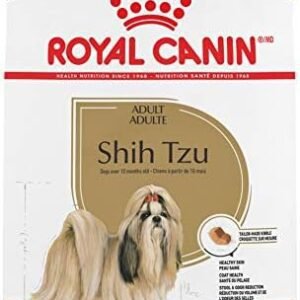Chlorhexidine is a widely used antiseptic and disinfectant in veterinary medicine, particularly for dogs. This medication is essential in canine healthcare due to its broad-spectrum efficacy against bacteria, fungi, and some viruses. It is commonly used to treat skin infections, oral conditions, and to clean wounds, ensuring that infections are controlled and healing is promoted.
Chlorhexidine’s versatility and effectiveness make it a staple in veterinary practices, providing a reliable solution for maintaining canine health and hygiene.
| Essential Drug Information | Details |
|---|---|
| Common Names | Chlorhexidine, Chlorhexidine Gluconate |
| Drug Type | Antiseptic, Disinfectant |
| Used For | Skin infections, Oral hygiene, Wound cleaning |
| Administered | Topical solution, Oral rinse, Shampoo, Spray |
| FDA Approved | Yes |

Chlorhexidine’s role in preventing and treating infections is crucial, especially in managing conditions like hot spots, gingivitis, and surgical wounds. Its ability to inhibit microbial growth helps in reducing the risk of complications and promotes faster recovery in dogs. This makes it an invaluable tool for veterinarians and pet owners alike, ensuring the well-being of our furry friends.
Table of Contents
Understanding Chlorhexidine
What is Chlorhexidine?
Chlorhexidine is a potent antiseptic and disinfectant widely used in both human and veterinary medicine. Its chemical structure, C({22})H({30})Cl({2})N({10}), allows it to effectively combat a broad spectrum of microorganisms, including bacteria, fungi, and some viruses. Initially introduced in the 1950s, Chlorhexidine has become a staple in medical practices due to its efficacy and safety profile. In veterinary medicine, it is particularly valued for its role in managing and preventing infections in dogs.
Chlorhexidine is available in various forms, including solutions, shampoos, sprays, and wipes, making it versatile for different applications. It is commonly used for skin disinfection before surgeries, cleaning wounds, treating oral conditions, and managing skin infections. Its ability to adhere to skin and mucous membranes enhances its effectiveness, providing a prolonged antimicrobial effect.
How Does Chlorhexidine Work in Dogs’ Bodies?
Chlorhexidine works by disrupting the cell membranes of microorganisms, leading to their destruction. When applied to a dog’s skin or mucous membranes, it binds to the negatively charged bacterial cell walls, causing leakage of intracellular components and ultimately cell death. This mechanism is effective against a wide range of bacteria, including both Gram-positive and Gram-negative species, as well as certain fungi and viruses.
In dogs, Chlorhexidine is primarily used topically. When applied to the skin, it helps to clean and disinfect wounds, reducing the risk of infection and promoting healing. In oral applications, such as mouth rinses, it helps to control plaque and gingivitis by reducing the bacterial load in the mouth. Chlorhexidine’s ability to remain active on the skin and mucous membranes for an extended period enhances its antimicrobial efficacy, making it a reliable choice for preventing and treating infections in dogs.
Common Conditions and Ailments in Dogs Treated with Chlorhexidine
Chlorhexidine is used to manage a variety of conditions in dogs, thanks to its broad-spectrum antimicrobial properties. Some of the most common conditions treated with Chlorhexidine include:
- Skin Infections: Chlorhexidine is highly effective in treating bacterial and fungal skin infections. Conditions such as pyoderma, hot spots, and yeast infections can be managed with Chlorhexidine shampoos or sprays. Its ability to penetrate the skin and eliminate pathogens makes it a preferred choice for veterinarians.
- Wound Care: For minor cuts, abrasions, and surgical wounds, Chlorhexidine solutions are used to clean and disinfect the area, preventing infection and promoting faster healing. Its gentle action ensures that it does not irritate the wound while providing effective antimicrobial protection.
- Oral Health: Chlorhexidine is commonly used in veterinary dentistry to manage periodontal diseases and gingivitis. Oral rinses containing Chlorhexidine help reduce plaque and bacterial load in the mouth, improving overall oral hygiene and preventing dental diseases.
- Ear Infections: Chlorhexidine solutions are also used to treat otitis externa, an infection of the outer ear canal. Its antimicrobial properties help eliminate the bacteria and fungi causing the infection, providing relief from symptoms and preventing recurrence.
- Paw Problems: Dogs often suffer from paw issues such as interdigital dermatitis and fungal infections. Chlorhexidine wipes or soaks can be used to clean and disinfect the paws, reducing inflammation and promoting healing.
- Pre-Surgical Preparation: Before surgical procedures, Chlorhexidine is used to disinfect the surgical site, reducing the risk of postoperative infections. Its broad-spectrum activity ensures that the area is free from harmful microorganisms, providing a sterile environment for surgery.
- Allergic Dermatitis: In cases of allergic dermatitis, Chlorhexidine can help manage secondary bacterial infections that often accompany the condition. By controlling the bacterial load on the skin, it helps reduce inflammation and itching, providing relief to the affected dog.
Chlorhexidine’s versatility and effectiveness make it an invaluable tool in veterinary medicine. Its ability to manage a wide range of conditions with minimal side effects ensures that it remains a preferred choice for veterinarians and pet owners alike. When used as directed, Chlorhexidine can significantly improve the health and well-being of dogs, ensuring they lead happy and healthy lives.
Benefits of Chlorhexidine for Dogs
Effectiveness in Treating Specific Canine Health Issues
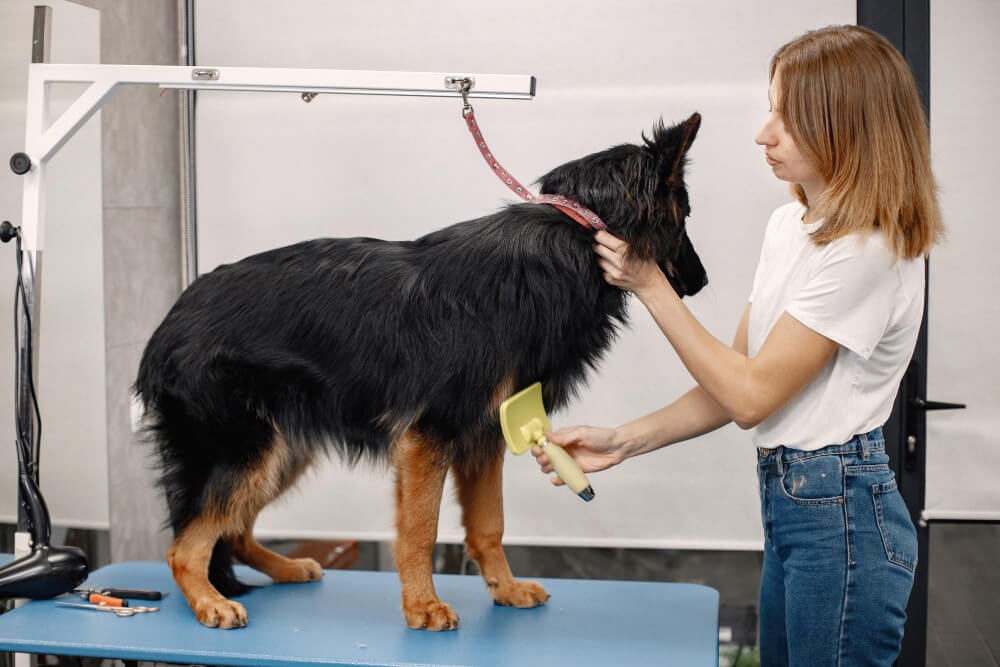
Chlorhexidine is a powerful antiseptic and disinfectant that has proven to be highly effective in treating a variety of canine health issues. Its broad-spectrum antimicrobial properties make it a versatile tool in veterinary medicine, capable of combating bacteria, fungi, and some viruses. Here are some specific health issues in dogs that Chlorhexidine effectively treats:
- Skin Infections: Chlorhexidine is widely used to treat bacterial and fungal skin infections in dogs. Conditions such as pyoderma, hot spots, and yeast infections can be managed effectively with Chlorhexidine shampoos, sprays, or wipes. Its ability to penetrate the skin and eliminate pathogens helps reduce inflammation and promote healing.
- Wound Care: For minor cuts, abrasions, and surgical wounds, Chlorhexidine solutions are used to clean and disinfect the area, preventing infection and promoting faster healing. Its gentle action ensures that it does not irritate the wound while providing effective antimicrobial protection.
- Oral Health: Chlorhexidine is commonly used in veterinary dentistry to manage periodontal diseases and gingivitis. Oral rinses containing Chlorhexidine help reduce plaque and bacterial load in the mouth, improving overall oral hygiene and preventing dental diseases.
- Ear Infections: Chlorhexidine solutions are also used to treat otitis externa, an infection of the outer ear canal. Its antimicrobial properties help eliminate the bacteria and fungi causing the infection, providing relief from symptoms and preventing recurrence.
- Paw Problems: Dogs often suffer from paw issues such as interdigital dermatitis and fungal infections. Chlorhexidine wipes or soaks can be used to clean and disinfect the paws, reducing inflammation and promoting healing.
- Pre-Surgical Preparation: Before surgical procedures, Chlorhexidine is used to disinfect the surgical site, reducing the risk of postoperative infections. Its broad-spectrum activity ensures that the area is free from harmful microorganisms, providing a sterile environment for surgery.
- Allergic Dermatitis: In cases of allergic dermatitis, Chlorhexidine can help manage secondary bacterial infections that often accompany the condition. By controlling the bacterial load on the skin, it helps reduce inflammation and itching, providing relief to the affected dog.
How Chlorhexidine Can Improve Dogs’ Quality of Life
Chlorhexidine’s effectiveness in treating various health issues directly translates to an improved quality of life for dogs. Here are some ways in which Chlorhexidine can enhance the well-being of our canine companions:
- Reduced Discomfort and Pain: By effectively treating infections and inflammations, Chlorhexidine helps reduce the discomfort and pain associated with these conditions. For instance, treating hot spots or skin infections with Chlorhexidine can alleviate itching and irritation, allowing dogs to feel more comfortable and less stressed.
- Enhanced Healing: Chlorhexidine promotes faster healing of wounds and infections by eliminating harmful microorganisms and preventing secondary infections. This accelerated healing process means that dogs can recover more quickly from injuries and surgeries, reducing the time they spend in discomfort.
- Improved Oral Health: Regular use of Chlorhexidine in oral care routines helps maintain good oral hygiene, preventing dental diseases such as gingivitis and periodontal disease. Healthy teeth and gums contribute to overall well-being, as dental issues can lead to pain, difficulty eating, and systemic infections if left untreated.
- Prevention of Recurring Infections: Chlorhexidine’s long-lasting antimicrobial action helps prevent the recurrence of infections. For dogs prone to chronic skin or ear infections, regular use of Chlorhexidine can keep these conditions at bay, reducing the frequency and severity of flare-ups.
- Better Skin and Coat Health: By managing skin infections and conditions like allergic dermatitis, Chlorhexidine helps maintain healthy skin and a shiny coat. Healthy skin is less prone to irritation and infections, contributing to a dog’s overall appearance and comfort.
- Increased Mobility and Activity: Treating paw problems and skin infections with Chlorhexidine can improve a dog’s mobility and willingness to engage in physical activities. When dogs are free from pain and discomfort, they are more likely to be active, which is essential for their physical and mental health.
- Enhanced Bonding with Owners: A healthy dog is a happy dog, and when dogs feel good, they are more likely to engage positively with their owners. Regular grooming and care routines that include Chlorhexidine can strengthen the bond between dogs and their owners, as these activities provide opportunities for interaction and affection.
- Prevention of Secondary Complications: By effectively managing infections and inflammations, Chlorhexidine helps prevent secondary complications that can arise from untreated conditions. For example, untreated skin infections can lead to more severe systemic infections, while untreated dental issues can result in tooth loss and systemic health problems.
Administering Chlorhexidine to Dogs
Dosage Guidelines: Determining the Right Dosage for Your Dog’s Size and Condition
Administering the correct dosage of Chlorhexidine is crucial for its effectiveness and safety. The dosage depends on the dog’s size, age, and the specific condition being treated. Below is a general dosage chart for Chlorhexidine, but always consult your veterinarian for precise instructions tailored to your dog’s needs.
| Age | Weight | Height | Dosage (Topical Solution) | Dosage (Oral Rinse) |
|---|---|---|---|---|
| Puppy | <10 lbs | <10 inches | 0.5-1 ml per application | 0.5 ml per rinse |
| Adult | 10-25 lbs | 10-15 inches | 1-2 ml per application | 1 ml per rinse |
| Adult | 25-50 lbs | 15-20 inches | 2-3 ml per application | 2 ml per rinse |
| Adult | >50 lbs | >20 inches | 3-5 ml per application | 3 ml per rinse |
Note: These dosages are approximate and should be adjusted based on the specific product’s concentration and the veterinarian’s recommendations.
Frequency of Administration: Daily, Weekly, or As Needed
The frequency of Chlorhexidine administration depends on the condition being treated and the product used. Here are some general guidelines:
- Skin Infections: For treating skin infections, Chlorhexidine can be applied once or twice daily until the infection clears up. For maintenance, it can be used once a week.
- Wound Care: For wound care, Chlorhexidine should be applied once daily until the wound heals.
- Oral Health: For oral health, Chlorhexidine rinses can be used once daily for active infections and once weekly for maintenance.
- Ear Infections: For ear infections, Chlorhexidine solutions can be used once or twice daily as directed by the veterinarian.
Directions for Use: Tips for Administering Chlorhexidine to Dogs
Administering Chlorhexidine to dogs can be straightforward with the right approach. Here are some tips to make the process easier:
- Topical Application:
- Clean the Area: Before applying Chlorhexidine, clean the affected area with water or saline solution to remove debris and pus.
- Apply the Solution: Soak a cotton ball or gauze pad with Chlorhexidine and gently dab it onto the affected area. Do not rinse off; let it dry naturally.
- Repeat as Needed: Depending on the severity of the condition, repeat the application as directed by your veterinarian.
- Oral Rinse:
- Measure the Dose: Use a syringe or dropper to measure the correct dose of Chlorhexidine oral rinse.
- Administer the Rinse: Lift your dog’s upper lip to expose the teeth and gums. Gently squirt the rinse along the gum line.
- Avoid Food and Water: Prevent your dog from eating or drinking for at least 30 minutes after administering the rinse to ensure maximum effectiveness.
- Hiding in Treats:
- Mix with Food: If your dog resists direct application, mix the Chlorhexidine solution with a small amount of wet food or a treat.
- Use Pill Pockets: For oral tablets or capsules, use pill pockets to hide the medication and make it more palatable.
- General Tips:
- Wear Gloves: To avoid contamination and protect your skin, wear gloves when applying Chlorhexidine.
- Be Gentle: Handle your dog gently and calmly to reduce stress and make the process smoother.
- Positive Reinforcement: Reward your dog with treats and praise after administering Chlorhexidine to create a positive association.
Missed Dose Guideline: Importance of Adhering to Prescribed Dosages
Adhering to the prescribed dosage schedule is crucial for the effectiveness of Chlorhexidine treatment. Here are some guidelines for managing missed doses:
- Administer as Soon as Possible: If you miss a dose, administer it as soon as you remember. However, if it is close to the time for the next dose, skip the missed dose and continue with the regular schedule.
- Do Not Double Dose: Avoid giving a double dose to make up for the missed one, as this can lead to overdose and potential side effects.
- Set Reminders: Use alarms or reminders on your phone to ensure you administer the medication on time.
- Consistency is Key: Consistent administration of Chlorhexidine ensures that the medication maintains its effectiveness and helps in the timely resolution of the condition.
Potential Side Effects and Precautions
Common Side Effects of Chlorhexidine in Dogs
Chlorhexidine is generally well-tolerated by dogs, but like any medication, it can cause side effects in some cases. The most common side effects are usually mild and localized to the area of application. These include:
- Skin Irritation: This can manifest as redness, itching, or a rash at the site of application. Dogs with sensitive skin or those receiving frequent applications may be more prone to irritation.
- Dryness: Chlorhexidine can sometimes cause dryness of the skin, leading to flaking or scaling.
- Discoloration: Prolonged use of Chlorhexidine, especially in oral rinses, can lead to discoloration of the teeth or fur.
While these side effects are typically mild and resolve on their own, it is important to monitor your dog for any signs of discomfort and consult your veterinarian if symptoms persist.
Identifying Severe or Adverse Reactions
In rare cases, dogs may experience more severe reactions to Chlorhexidine. These adverse reactions can include:
- Allergic Reactions: Symptoms of an allergic reaction can include swelling, hives, difficulty breathing, and anaphylaxis. If your dog shows any signs of an allergic reaction, discontinue use immediately and seek veterinary care.
- Gastrointestinal Issues: If Chlorhexidine is ingested, it can cause vomiting, diarrhea, and stomach discomfort. This is more likely to occur if the dog licks the treated area or ingests the oral rinse.
- Severe Skin Reactions: In some cases, Chlorhexidine can cause severe skin reactions such as blistering, peeling, or severe redness. These reactions require immediate veterinary attention.
It is crucial to observe your dog closely after administering Chlorhexidine, especially during the initial uses, to ensure they do not develop any severe reactions.
Precautions for Pregnant or Lactating Dogs
Using Chlorhexidine in pregnant or lactating dogs requires special precautions. While Chlorhexidine is generally considered safe, it is essential to consult with a veterinarian before use. Here are some key considerations:
- Consultation with Veterinarian: Always consult your veterinarian before using Chlorhexidine on pregnant or lactating dogs. They can provide guidance on the appropriate usage and dosage based on your dog’s specific condition.
- Avoid Ingestion: Ensure that the dog does not ingest Chlorhexidine, as it can cause gastrointestinal issues. This is particularly important for lactating dogs, as the puppies could be exposed to the medication through the mother’s milk.
- Monitor for Reactions: Pregnant and lactating dogs may have heightened sensitivities. Monitor them closely for any signs of adverse reactions and discontinue use if any symptoms occur7.
Interactions with Other Medications or Supplements
Chlorhexidine is generally safe to use with most medications and supplements, but there are some important considerations to keep in mind:
- Topical Interactions: Avoid using Chlorhexidine in combination with other topical treatments without veterinary guidance. Mixing it with other topical agents can alter its effectiveness or lead to unexpected reactions.
- Systemic Medications: Chlorhexidine does not typically interact with systemic medications, but it is always best to consult your veterinarian if your dog is on other medications.
- Enhanced Effectiveness: Chlorhexidine is often combined with other medications, such as miconazole or ketoconazole, to enhance its effectiveness in treating fungal infections. Ensure that any combination treatments are approved by your veterinarian.
Comparison with Similar Drugs in This Category
Comparing Efficacy of Drugs
Chlorhexidine is a widely used antiseptic in veterinary medicine, known for its broad-spectrum antimicrobial properties. However, it is not the only option available for treating infections in dogs. Here, we compare the efficacy of Chlorhexidine with other similar drugs:
- Chlorhexidine vs. Povidone-Iodine:
- Efficacy: Both Chlorhexidine and Povidone-Iodine are effective antiseptics. Chlorhexidine is particularly effective against Gram-positive and Gram-negative bacteria, fungi, and some viruses1. Povidone-Iodine also has broad-spectrum antimicrobial activity but is more effective against a wider range of viruses.
- Usage: Chlorhexidine is often preferred for skin infections, oral hygiene, and wound care due to its prolonged antimicrobial action. Povidone-Iodine is commonly used for pre-surgical skin preparation and wound cleaning.
- Side Effects: Chlorhexidine is generally well-tolerated but can cause skin irritation in some dogs. Povidone-Iodine can cause skin staining and may be irritating to sensitive skin.
- Chlorhexidine vs. Hydrogen Peroxide:
- Efficacy: Chlorhexidine provides a longer-lasting antimicrobial effect compared to Hydrogen Peroxide, which has a short duration of action. Hydrogen Peroxide is effective for initial wound cleaning due to its effervescent action that helps remove debris.
- Usage: Chlorhexidine is used for ongoing infection control, while Hydrogen Peroxide is often used for initial wound cleaning.
- Side Effects: Chlorhexidine can cause mild skin irritation. Hydrogen Peroxide can be harsh on tissues and may impede healing if used excessively.
- Chlorhexidine vs. Benzoyl Peroxide:
- Efficacy: Chlorhexidine is effective against a broad range of microorganisms. Benzoyl Peroxide is particularly effective against Propionibacterium acnes and is used for its keratolytic and antiseborrheic properties.
- Usage: Chlorhexidine is used for general antiseptic purposes, while Benzoyl Peroxide is often used for treating pyoderma and seborrheic dermatitis.
- Side Effects: Chlorhexidine is generally well-tolerated. Benzoyl Peroxide can cause skin dryness and irritation.
Comparing Which Alternative is Chosen When
The choice of antiseptic depends on the specific condition being treated, the dog’s overall health, and the veterinarian’s preference. Here are some scenarios where different antiseptics might be chosen:
- Skin Infections:
- Chlorhexidine: Preferred for its broad-spectrum efficacy and prolonged action.
- Benzoyl Peroxide: Chosen for cases involving seborrheic dermatitis or pyoderma due to its keratolytic properties.
- Wound Care:
- Chlorhexidine: Used for ongoing infection control and wound cleaning.
- Hydrogen Peroxide: Used for initial wound cleaning to remove debris.
- Pre-Surgical Preparation:
- Chlorhexidine: Commonly used due to its prolonged antimicrobial action.
- Povidone-Iodine: Preferred for its broad-spectrum efficacy, especially against viruses.
- Oral Hygiene:
- Chlorhexidine: Used in oral rinses to control plaque and gingivitis.
- Hydrogen Peroxide: Less commonly used due to its potential to irritate oral tissues.
- Ear Infections:
- Chlorhexidine: Used in ear cleaning solutions for its antimicrobial properties.
- Povidone-Iodine: Less commonly used due to potential irritation.
Comparing the Cost of the Drug
The cost of antiseptic drugs can vary based on the formulation, brand, and concentration. Here is a general comparison of the costs:
- Chlorhexidine:
- Cost: Chlorhexidine products are generally affordable, with prices ranging from $10 to $30 for solutions, shampoos, and wipes.
- Availability: Widely available in various formulations, including solutions, shampoos, sprays, and wipes.
- Povidone-Iodine:
- Cost: Povidone-Iodine is also affordable, with prices ranging from $5 to $20 for solutions and ointments.
- Availability: Readily available in most pharmacies and veterinary supply stores.
- Hydrogen Peroxide:
- Cost: Hydrogen Peroxide is very inexpensive, typically costing less than $5 for a bottle.
- Availability: Easily available in pharmacies and general stores.
- Benzoyl Peroxide:
- Cost: Benzoyl Peroxide products are moderately priced, ranging from $10 to $25 for shampoos and gels.
- Availability: Available in veterinary supply stores and online.
In conclusion, while Chlorhexidine is a highly effective and versatile antiseptic for dogs, there are several alternatives available, each with its own advantages and specific uses. The choice of antiseptic depends on the condition being treated, the dog’s overall health, and the veterinarian’s preference. Cost considerations also play a role, with Chlorhexidine and its alternatives being generally affordable and widely available.
Consultation with a Veterinarian
Emphasizing the Importance of Professional Guidance
Consulting with a veterinarian before using Chlorhexidine on your dog is crucial. Veterinarians can provide personalized advice based on your dog’s specific health needs, ensuring the correct dosage and application method. They can also help identify the underlying cause of your dog’s condition and recommend the most effective treatment plan. Professional guidance minimizes the risk of adverse reactions and ensures the safe and effective use of Chlorhexidine.
Overdose Information and Possible Toxicity/Effect
While Chlorhexidine is generally safe for dogs, an overdose can lead to potential toxicity. Ingesting large amounts can cause gastrointestinal upset, including vomiting and diarrhea. Overuse on the skin can lead to irritation, dryness, and even chemical burns. It’s essential to follow the veterinarian’s dosage instructions carefully and avoid excessive application. If you suspect an overdose, contact your veterinarian immediately.
Signs or Symptoms When to Call the Vet
It’s important to monitor your dog for any signs of adverse reactions when using Chlorhexidine. Common symptoms that warrant a call to the vet include:
- Redness or swelling at the application site
- Itching or hives
- Vomiting or diarrhea if ingested
- Lethargy or unusual behavior
If your dog exhibits any of these symptoms, discontinue use and seek veterinary care promptly.
How to Discuss Chlorhexidine with Your Veterinarian
When discussing Chlorhexidine with your veterinarian, be open about your dog’s health history and any other medications or supplements they are taking. Ask about the appropriate dosage, application methods, and potential side effects. If you have concerns or notice any adverse reactions, don’t hesitate to seek a second opinion. A thorough discussion with your veterinarian ensures that you are well-informed and confident in the treatment plan for your dog.
Where to buy chlorhexidine for dogs
These products offer a range of options for different needs, from skin and ear infections to oral hygiene. Always consult with your veterinarian to choose the best product for your dog’s specific condition.
Frequently Asked Questions (FAQs)
1. Can I use Chlorhexidine on my puppy?
Yes, Chlorhexidine can be safely used on puppies. Always follow the directions and consult with your veterinarian to ensure the correct concentration and application method.
2. How often should I apply Chlorhexidine to my dog?
The frequency of application depends on the condition being treated. Typically, Chlorhexidine is applied 1-3 times daily for active infections and once weekly for maintenance.
3. Can I use human Chlorhexidine products on my dog?
While it is generally safe, it is best to use products specifically formulated for pets. Always consult with your veterinarian to ensure the right concentration and formulation for your dog.
4. What should I do if my dog licks the area where I applied Chlorhexidine?
If your dog licks the treated area, it may cause mild gastrointestinal upset. Monitor your dog for any signs of vomiting or diarrhea and contact your veterinarian if symptoms persist.
5. Can Chlorhexidine be used for ear infections in dogs?
Yes, Chlorhexidine solutions can be used to treat ear infections. However, it is important to use a product specifically designed for ear cleaning and follow your veterinarian’s instructions.
6. Is Chlorhexidine safe for long-term use?
Chlorhexidine is generally safe for long-term use when used as directed. However, prolonged use can sometimes lead to skin dryness or irritation. Consult your veterinarian for guidance on long-term use.
7. Can Chlorhexidine cause allergic reactions in dogs?
Although rare, some dogs may experience allergic reactions to Chlorhexidine. Symptoms can include redness, swelling, and itching. If you notice any of these signs, discontinue use and contact your veterinarian immediately.
8. How should I store Chlorhexidine products?
9. Can Chlorhexidine be used on open wounds?
Chlorhexidine can be used on minor cuts and abrasions, but it is important to follow your veterinarian’s advice. Avoid using it on deep or severe wounds without professional guidance.
10. What should I do if I miss a dose of Chlorhexidine?
If you miss a dose, apply it as soon as you remember. If it is close to the time for the next dose, skip the missed dose and continue with the regular schedule. Do not double the dose to make up for the missed one.

















